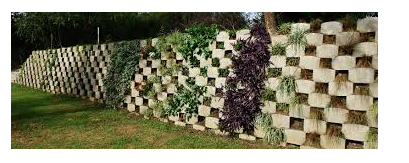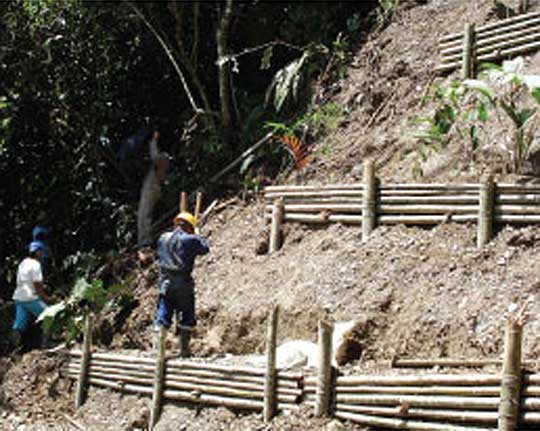Soil erosion is the result of several natural and man-made factors. For the most part, things like rainfall (amount and intensity), the erodibility of the soil, and the slope, cannot be modified by farmers. Bare soil will erode much more than soil with crops or other plants growing on it. After crops have been harvested, it is the non-harvested residue that can be laid on the surface of the soil to protect it during the time when there are no crops on the field.
The one thing that farmers can do to reduce erosion is to protect it from the impact of falling raindrops. This can be done by maintaining an adequate soil cover, either with vegetation or residues from the previous crops.
Practices that remove residue after harvest (such as burning) should be avoided or kept to a minimum.
The following cost-saving structures are all used as small structures in catchment areas of less than 5km2. The structures are established at less productive times when labour employed for extensive farming can be utilized better. The structure should not be built on very steep slopes. However, the soil type will determine what constitutes a safe slope. The structures should be regarded as part of a pasture rehabilitation programme, aimed at long-term benefits. The purpose is to conserve moisture and to establish a seedbed.
The structures should be established in a strategic spot. This is usually where a few small gullies converge, where the slope is lesser than in the rest of the donga, or where a reef has been exposed clearly in the right position to the slope of the donga.
If the flow of the water is diverted by the small structure, the water must be left on a safe, hard stratum, or in the original bed, where there is no chance of erosion.
Gutter Structures
The gutter structure is used to move water from a more elevated part of the donga bed to a lower-lying terrace. The structure can be built from concrete, bricks or stone masonry.
An upstream cut-off wall of about half a meter below the floor, and a downstream cut-off wall extending all the way to the reef, is very important. The floor against a slope must be cast on a firm base. The water must be returned to the existing donga. The structures can be erected without great expense by using materials occurring in the vicinity, for example, sand and building/concrete stone.

Tyre Structures
Structures made from old car tyres must be attached very firmly to iron posts driven into the ground in each stack of tyres that are piled up. The tyres must be tied together, and they must be filled with stones. A layer of shade cloth must also be attached to the upstream surface of the tyres. This must extend from ground level to the top of the tyres. The tyres must be inserted into the sides of the dongas where they are used, in such a way as to prevent water from flowing between the tyres and the walls. Where excavations are made in the sides of the walls, the soil must be thoroughly compacted against the tyres after the piles had been stacked. The iron posts around which the piles are stacked must be anchored to one central pole upstream from the stacks. The upstream iron posts must be drivenas deep as possible into the ground.
These structures are not recommended unless great care is taken to stack them properly. Fast-flowing water can cause any number of problems.
Small Concrete Structures
Small concrete structures, brickwork, or stone masonry can be used in small gullies where the reefs are clearly exposed. The spill-over part of these small structures is not built higher than half a meter. The structures can be built in any shape. The shape must be simple and practical. If structures are built higher than half a meter, they must be designed, and correctly spaced buttresses must be added on the downstream side.
These structures are built to conserve moisture and to establish a seedbed on a bare reef. The reef must be cleaned very thoroughly to enable the concrete to bind. All loose material must be removed. If the reef is brittle, it cannot be used. The structures must be well-recessed into the sides of the donga. If the recesses are dug neatly, the brick/stone-work/concrete can be put in place without shuttering. Shuttering can be used where necessary. It is very important that the structures should have a floor on the downstream side to prevent erosion of the stone and damage to the structure. The object of this work is not to form dams.
Once the work has been overgrown or silted over, the idea is that it should blend in with the environment. To keep transport costs down as far as possible, the structures should preferably be built with materials found in the vicinity. No brittle stones should be used for building since this would weaken the structure. Use stones of 150-200mm in diameter for stone-work.

Bare Spots (Brackish Spots)
Branches can be used to cover bare spots to prevent them from drying out so soon after rain. It is advisable to break up the spots with an implement to form holes in which water can collect.
Loosening of the soil also breaks the upper crust and brings some of the subsoils to the surface. To this end, the spade plough or ripper can be used.

Stone Stacks (With or Without Wire Baskets)
Stone stacks can be used almost everywhere with great success. The stones must be stacked correctly to enable them to absorb the force of the water. Where steep slopes occur, it is preferable to stack stones in wire baskets. The stones must be stacked together tightly to prevent the water from readily washing away loose stones. It is very important that the direction of the flow of the water should not be altered. The water must keep flowing in the donga and must merely flow over the structure. The slides of the stone stack must be higher than the part over which the water is supposed to flow.
The stone stacks are used to establish plant growth which would increase the carrying capacity of the area. They retard the run-off rate of the water, which results in increased infiltration of the soil. In the long term, this can benefit the underground sources of water. The paddocks, in which the structures occur, must be continuously monitored to ensure that the vegetation is established around the structures is not damaged by grazing stock. If seeds are sown to accelerate rehabilitation, only seeds that belong to the immediate vicinity must be used. Avoid all strange or alien seeds, which could result in problems with alien vegetation.
In areas where more than 500mm of rain occurs annually, rehabilitation work can be done with grass sods. The sods can be placed in strategic spots, where water is available, to cover the ground and prevent further erosion.
